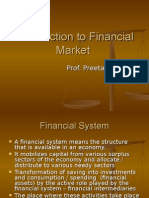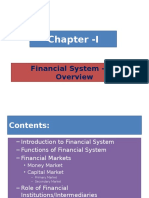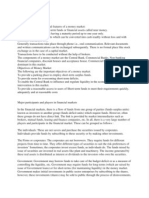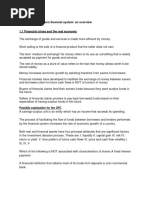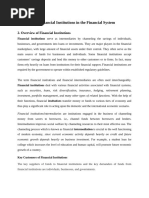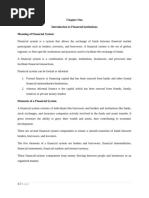BBMF2013 Tutorial Answers Chapter 2 Financial Environment
Uploaded by
mathisfun.malaysiaBBMF2013 Tutorial Answers Chapter 2 Financial Environment
Uploaded by
mathisfun.malaysiaCommercial bank
Investment bank
Insurance
Tutorial 2 Unit Trust
Pension Fund
1. What are “financial intermediaries”? How can you tell whether they are acting as a broker and principal?
forum/platform individual, business,government
Financial intermediaries are organisations that brings that brings together potential borrowers and potential
lenders. A lender does not need to find an individual borrower but can deposit his money with a bank, building
society, investment trust or other financial intermediary. An intermediary can act as a broker, handling a
transaction on behalf of others or as a principal holding money balances of lenders for lending on to borrowers
2. Discuss about the general roles of the financial intermediaries and briefly discuss the key benefits of the
financial intermediation functions/duties/reasons/benefits/characteristics
Roles of financial intermediaries
-1.Advisory customize a loan for individuals or institutions according to their requirements.
Advice customers on financial matters
Exp : best way to invest their funds
Helps to encourage the flow of saving
2.
- Channeling funds
Able to channel funds to those area that yield the highest return
Gives confidence – saving will earn a good interest
Help to ensure that potentially profitable project able to obtain finance
3.
- Transmitting payments
Use of cheques , debit cards , credit cards , standing order
Can be transfer from one person to another without rely on cash
4.
- Maturity Transformation
Lends for longer period of time than they borrow
Borrow money for long period and depositors want to withdraw on demand
5.
- Risk Transformation
Wiling to take risk
Can absorb the loss – the interest earn on the loans
Benefits of financial intermediation
6.
- By linking lenders and borrowers
Able to package the amount they lent into the amount
Exp: Banks gather small saving from individuals and repackaging into large bundle
7.
- Risk reduction
Effected by unit trust companies
Exp : Spreading of investment - enable small investor to take advantage of the effect of portfolio
Exp : Bank will make lending to different industries
8.
- Maturity Transformation
Bridging the gap between lenders and borrowers
Exp : Bank – borrowing short and lending long
Reconcile the maturity difference between savers and borrowers
9.
- Reduce the level of transaction
Individual investor - large number of small transaction in order to achieve diversification
Financial intermediaries is to transform savings into investments.
10. Financial intermediaries give long-term and short-term loans.
These institutions accept deposits from entities that have surplus
- Provide information Others?
cash with them and provide loans, either short-term or long-term,
to entities or institutions that are in deficit and require funds to
Improve the efficiency of markets run their functions. -->maturity transformation
Financial intermediaries offering professional service and
11. investment products that help both individuals and entities widen
- Solve the problem of scarcity their returns and reduce financial risks.--> link between
borrowers/lenders. solve problem of scarcity
Commercial bank , leasing companies – gather financial resources and distributes them to productive units
12. - risk management (reduce risk) - protect - regulated - secured
- reduce time - proper platform - so easy to do any transactions
13. related - just online
6-8 marks - some Financial Intermediation - offer liquidity securities - company
= 5 - 6 key points
14. want to find any liquidity instrument - easy
3. Who are the key participants in the transactions of financial institutions? Who are net suppliers and who are
net demanders?
The key participants in financial transactions are individuals, businesses, and governments.
These parties participate both as suppliers and demanders of funds.
Individuals are net suppliers, which means that they save more dollars than they borrow, while both businesses
and governments are net demanders since they borrow more than they save.
One could say that individuals provide the excess funds required by businesses and governments
functions
4. What role do financial markets play in our economy? What are primary and secondary markets?
What relationship exists between financial institutions and financial markets?
Financial markets provide a forum in which suppliers of funds and demanders of loans and investments can
transact business directly. Newly formed (issued) securities are bought or sold in primary
(first time) markets.
Primary market is the name used to denote the fact that a security is being issued by the demander of funds to the
supplier of funds. An example would be Microsoft Corporation selling new shares of common stock to the public.
existing securities
Secondary market refers to the trading of securities among investors subsequent to the primary market issuance.
In secondary market trading, no new funds are being raised by the demander of funds. The security is trading
ownership among investors. An example would be individual “A” buying common stock of Microsoft through a
broker from individual “B”. 'Financial System'
related
Financial institutions and financial markets are not independent of each other. It is quite common to find financial
institutions actively participating in both the money market and the capital market as both suppliers and
demanders of funds. Financial institutions often channel their investments and obtain needed financing through
the financial markets. This relationship exists since these institutions must use the structure of the financial
marketplace to find a supplier of funds Insurance - received premium - pool of money-allocate for claim, allocate
for investment (invest into financial market:
5. Define ‘money market’. short term securities i.e Banker acceptance,long term: REITs)
The money market is a financial relationship between the suppliers and demanders of short-term debt securities
maturing in one year or less, such as Treasury bills, commercial paper, and negotiable certificates of deposit.
Money market instrument serve
The main difference between the primary and the the dual purpose of allowing
secondary market is when securities issued by the borrowers meet their short-term
Company are traded in the Primary market. No requirements and providing easy
further trades are carried out in the primary liquidity to lenders.
market.
The secondary market is the place where the
existing holders trade the securities with the new
buyers in the market. The investors can carry out
trading the securities in the secondary market as
many times as they want.
You might also like
- Chapter 3, Basic Elements of Financial System100% (1)Chapter 3, Basic Elements of Financial System27 pages
- Wharton Casebook 2010 For Case Interview Practice - MasterTheCase100% (25)Wharton Casebook 2010 For Case Interview Practice - MasterTheCase81 pages
- Chapter # 2: Overview of The Financial SystemNo ratings yetChapter # 2: Overview of The Financial System16 pages
- What Is A Financial Intermediary (Final)No ratings yetWhat Is A Financial Intermediary (Final)6 pages
- Chapter 2 Financial Intermediaries and Other ParticipantsNo ratings yetChapter 2 Financial Intermediaries and Other Participants45 pages
- Module 2 - Financial Institutions and MarketsNo ratings yetModule 2 - Financial Institutions and Markets14 pages
- Cifa Financial Institutions and Markets PDFNo ratings yetCifa Financial Institutions and Markets PDF104 pages
- An Introduction To A Financial System and Its ConstituentsNo ratings yetAn Introduction To A Financial System and Its Constituents32 pages
- Financial Institutions and Financial MarketsNo ratings yetFinancial Institutions and Financial Markets5 pages
- Sathyabama University Faculty of Business AdministrationNo ratings yetSathyabama University Faculty of Business Administration16 pages
- The Basic Functions of The Financial System Group1No ratings yetThe Basic Functions of The Financial System Group125 pages
- Financial Institutions & Financial Markets Module - 1: by Sanjeev TamhaneNo ratings yetFinancial Institutions & Financial Markets Module - 1: by Sanjeev Tamhane35 pages
- (Takes Notes) Financial Institutions and MarketsNo ratings yet(Takes Notes) Financial Institutions and Markets51 pages
- Unit 1: - Investment Environment in India - Overview of Indian Financial System - Investment AlternativesNo ratings yetUnit 1: - Investment Environment in India - Overview of Indian Financial System - Investment Alternatives35 pages
- Mutual Funds - The Mutual Fund Retirement Plan For Long - Term Wealth BuildingFrom EverandMutual Funds - The Mutual Fund Retirement Plan For Long - Term Wealth BuildingNo ratings yet
- Case Study On Vicco Turmeric and Sunsilk Fruit Am Ins0% (1)Case Study On Vicco Turmeric and Sunsilk Fruit Am Ins24 pages
- Marketing Plan of Organic Honey - 20202097No ratings yetMarketing Plan of Organic Honey - 2020209716 pages
- Read The Following Text and List The Steps in Starting A Business As Well As Explain Four Elements Involved in Every BusinessNo ratings yetRead The Following Text and List The Steps in Starting A Business As Well As Explain Four Elements Involved in Every Business2 pages
- Taxability of Joint Development Agreement It GSTNo ratings yetTaxability of Joint Development Agreement It GST14 pages
- The Performance of Regulated Agricultural Market - A Case Study of Bhiwani District of HaryanaNo ratings yetThe Performance of Regulated Agricultural Market - A Case Study of Bhiwani District of Haryana14 pages
- St. Vincent College: Tuition Fee Per Unit at P400 Miscellaneous Fees100% (1)St. Vincent College: Tuition Fee Per Unit at P400 Miscellaneous Fees3 pages
- NMIMS Assignment Answer Sheet Dec 2020 Call 9025810064No ratings yetNMIMS Assignment Answer Sheet Dec 2020 Call 902581006477 pages
- Pre Investment Analysis of A Project With A View To Determining The Overall Feasibility and Measures Its Investment Worth Which Provides A Comprehensive ReviewNo ratings yetPre Investment Analysis of A Project With A View To Determining The Overall Feasibility and Measures Its Investment Worth Which Provides A Comprehensive Review2 pages
- A Study On Performance Evaluation of Mutual Funds MbaNo ratings yetA Study On Performance Evaluation of Mutual Funds Mba88 pages
- TUTORIAL QUESTION 3-Adm501 Presentation Slide Assignment MUZHAFARR & FARAHNo ratings yetTUTORIAL QUESTION 3-Adm501 Presentation Slide Assignment MUZHAFARR & FARAH14 pages
- Securities Crowdfunding Platform: Grow To ShareNo ratings yetSecurities Crowdfunding Platform: Grow To Share17 pages
- Sales & Distribution Management: Assignment OnNo ratings yetSales & Distribution Management: Assignment On9 pages

